Those who have not tried snowboarding may look at what we do and think it is stupid and Those who have not tried snowboarding may look at what we do and think it is stupid and dangerous. Most people make their minds up after watching fail videos of snowboarders crashing hard. If this is you, I understand why you may be put off snowboarding.
Snowboarding can be dangerous for a few reasons. Primarily the dangers come from the environments you ride in, rider ability, and how you approach the sport. You can stay relatively safe by using common sense, wearing protection, and learning how to ride properly.
Of course, sports like snowboarding come with increased risk due to their high speeds and technical nature. In this article, I’ll go into the dangers of snowboarding, how to ride safely, and why you shouldn’t be scared.
The Risks Of Snowboarding
Most things in life include some kind of risk. Just existing would be pretty difficult or boring if we didn’t face risk from time to time.
For example, you face danger when driving your car and can even risk injury by doing light exercise. Here are a few ways snowboarding can be dangerous and what you can do to manage the risk.
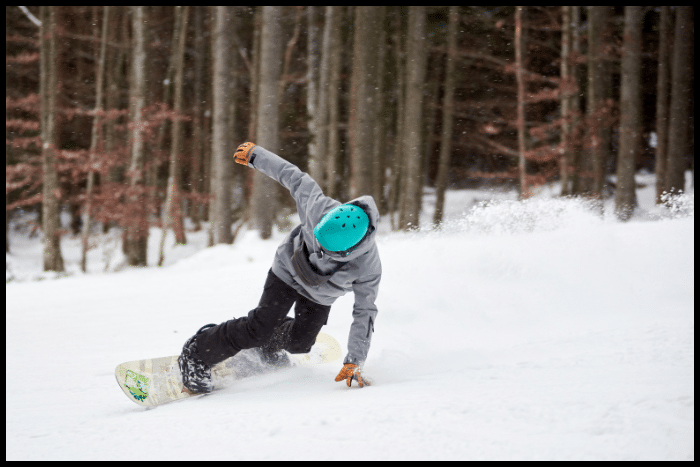
Your Experience And Riding Style
When you think about it, the better at snowboarding you are, the safer it should be.
This is because your movements become more natural, allowing you to react to changes in the snow and terrain and stay on your feet.
But, as skills progress, so does the allure of pushing boundaries.
This means that advanced riders tend to put themselves in more dangerous situations performing more complex tricks, going bigger, and taking on steeper and more challenging terrain, which increases risk.
Another aspect that makes snowboarding more dangerous is your riding style. If you ride aggressively and at high speed, you put yourself at more risk.
On the contrary, you are safer when riding within your limits and in control.
Various Mountain Environments
After you’ve been snowboarding for a while, you’ll notice that the mountains offer a wide variety of terrain for snowboarders of all types.
Most snowboarders will keep to the marked slopes within the resort’s boundaries.
These are the safest areas as the slopes are groomed with large machines and patrolled while most natural dangers are eliminated.
Snowboarders also like to hang out in the snow park, which is a special area within a ski resort with a collection of features.
These include jumps, rails, boxes, and other fun obstacles for freestyle snowboarding. Freestyle snowboarding is much more dangerous than riding around the groomed slopes.
The snow park is where you experiment with spins and other tricks, which take trial and error to perfect. This means you hit the ground hard, increasing your risk of injury.
If you want to be a freestyle snowboarder, you need to be prepared for broken bones and being taken down the mountain on a stretcher from time to time.
More advanced snowboarders like to go into the backcountry, which is the unpatrolled area of the mountain, where you have to look after yourself and the other people in your group.
The backcountry is incredibly rewarding, as it is where you find fresh powder away from the crowds.
Riding in the wilderness is special and addictive, but it can be incredibly dangerous if you don’t know what you’re doing.
How To Make Snowboarding Less Dangerous?
Most of the time, reducing risk while snowboarding comes down to common sense, learning about staying safe, and riding within your limits.
To become a better snowboarder, you need to push those limits, but it is essential only to do so when you’re ready. Here is how to manage risk in various mountain environments:
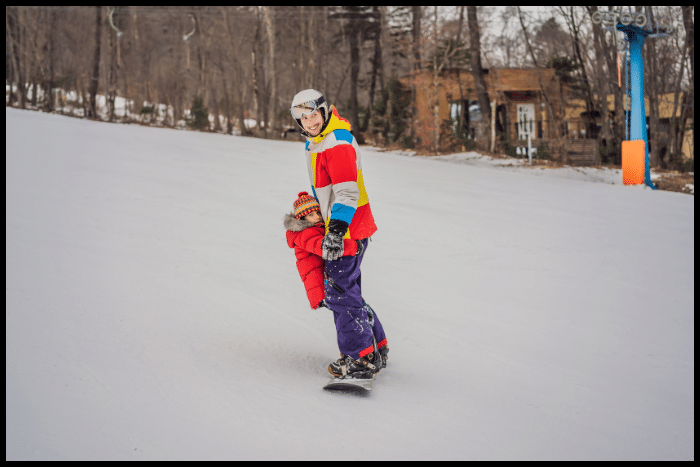
1. Staying Safe Riding On Marked Runs
The most important thing to do to stay safe when riding on marked runs is to stick to ones suited to your skill level. Ski resorts color-code their runs according to their difficulty.
Before you head up the mountain, make sure you know what these colors mean.
This way, you can head to the appropriate slopes for your skill level so you don’t get into a situation that results in a stretcher and a helicopter to a hospital.
However, it is worth noting that ski resorts vary in terrain. By this, I mean that a blue run in one resort can be more challenging than a blue in another.
Let’s break down the color-coded runs:
Green Runs: These gentle slopes are perfect for beginners, providing a super easy introduction to skiing or snowboarding.
Blue Runs: A step up in difficulty from green, these runs cater to beginner and intermediate skiers and snowboarders, making them ideal for practicing your skills.
Diamond Black Runs (Red in Europe): These slopes are only suitable for skiers and snowboarders at intermediate to advanced levels.
Double Diamond Black Runs (Black in Europe): These slopes are challenging for many reasons. They should only be ridden by advanced skiers and snowboarders.
2. Know The Mountain Rules
There are many rules associated with skiing and snowboarding in a resort. Most ski resorts print them on their maps or signs. But the most import and ones include:
Give way to the downhill rider: When on the slopes, the person downhill has the right of way. If you crash into them, it’s your fault.
Don’t stop in stupid places: Avoid stopping in hazardous locations such as the middle of the slope, below a roller, or on the landing of a jump.
Make sure that where you stop can be seen by other riders and don’t impede the flow of other riders.
Ride at a responsible speed: While racing down the hill can be fun, it’s important to exercise caution and ride at a responsible speed. Remember, there’s a time and place for everything.
3. Staying Safe In A Snowpark
The nature of freestyle snowboarding makes it more dangerous. But you can do a few things to reduce your risk of becoming a mangled mess with body parts pointing in new directions.
Firstly, ride through the park without hitting any of the kickers or features. This is so you can get a good look at each one and assess the landings.
It’s also beneficial to watch other riders hitting features you like the look of. This way, you can get a good idea of how fast you need to go to clear the knuckle safely.
Features are often color-coded in the same way as slopes to indicate how difficult they are. Therefore, you can start with smaller features and work up to larger ones when you feel more confident.
Snow parks can be busy, so being aware of your surroundings is essential. There is such a thing as snow park etiquette that will keep you safe and stop you from annoying others.
For example, there will often be people waiting to hit a feature, so wait your turn before dropping in.
Also, you should always look up the slope behind you before approaching a feature and never cut in front of anyone. If you wipe out on a landing, make sure you get up and out of the way as fast as you can.
You really don’t want to be still on the landing when the next rider hits the jump!
Riding safely in the park takes simple common sense and courtesy, but not everyone has these qualities.
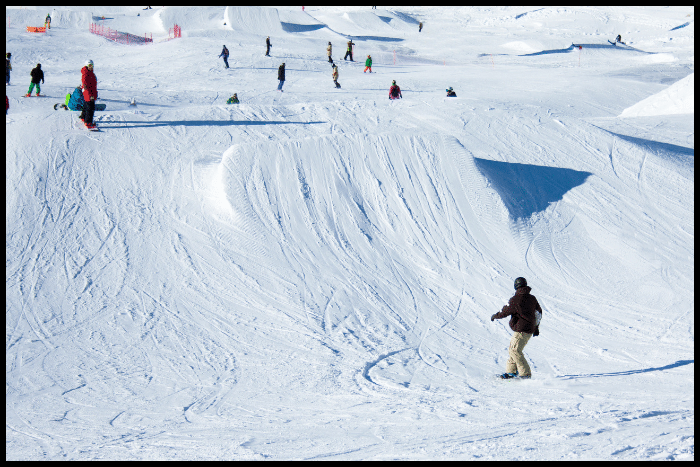
4. Staying Safe In The Backcountry
As I mentioned earlier, the backcountry can be incredibly dangerous, particularly to the uneducated, as there are many hidden hazards that can prove fatal.
Many riders often head into the backcountry without knowing what they are potentially letting themselves in for.
4a. Don’t Take Avalanche Risk Too Lightly
The primary hazard of backcountry snowboarding is avalanche risk, and it should be in everyone’s mind before they head out of bounds.
Before you consider going into the backcountry, you need to learn about avalanche awareness and rescue and the equipment involved.
4b. Avalanche Equipment
The basic avalanche equipment includes a transceiver, probe, and shovel. The transceiver is an electronic device that allows you to search for your buried avalanche victims or for them to find you.
The probe helps you pinpoint buried victims so that you can dig them out with your shovel.
Additionally, carrying an ABS backpack provides an extra layer of safety. An ABS backpack features an integrated airbag triggered by a ripcord on the shoulder strap.
In the event of an avalanche, pulling the ripcord inflates the airbag, increasing your buoyancy and keeping you closer to the surface for easier rescue.
While an ABS backpack is expensive and adds weight to your gear, the confidence and potential survival benefit it offers makes it worth considering.
It’s important to note that having an ABS backpack doesn’t mean you should take avalanche risk lightly—it increases your chances of survival but is not a guarantee.
Avalanche rescue equipment is quite expensive to buy. However, you can often rent it for a reasonable price from some ski shops.
4c. Avalanche Awareness Courses
Enrolling in an avalanche awareness course is highly recommended to ensure that you are as safe as possible in the backcountry.
These fun and informative sessions teach you how to stay safe, manage risk, and do the right thing if the worst happens.
When you go on an avalanche awareness course, your instructor often takes you to parts of the mountain you wouldn’t normally find on your own. So you get to ride fresh powder while learning how to stay safe.
Most ski and snowboard schools offer avalanche awareness courses, so if you have the ability to ride powder, booking a spot in one of these sessions expands your possibilities for enjoyable experiences on the mountain.
Personally, I make it a habit to ride in the backcountry as much as possible and attend these courses every winter to refresh my memory.
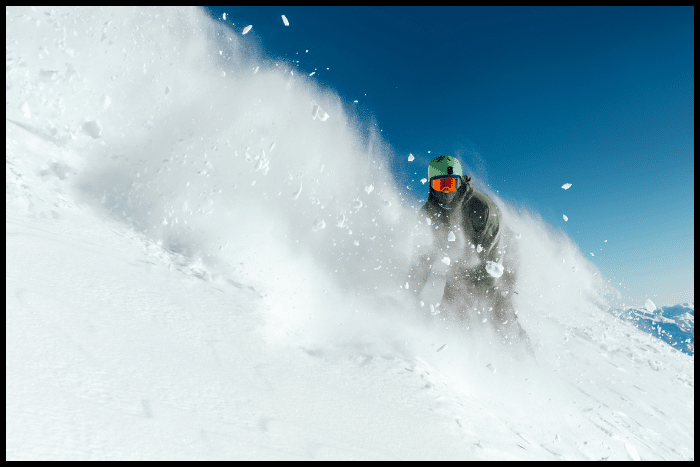
4d. Other Backcountry Hazards
In addition to avalanches, there are other hazards you should be aware of when venturing into the backcountry.
Crevasses
Crevasses are deep cracks in a glacier, often prominent in ski areas with high-altitude glaciers. Since glaciers are typically covered in snow, they are not always visible.
So, if you see a sign warning you that you’re in an area with crevasses, pay attention to it and stay away. If you ride over a snow-covered crevasse and the snow collapses, you can plummet to your death.
If the terrain you want to ride involves a glacier, booking a local guide is best, as they will know the safest places and help you avoid crevasses.
Tree Wells
Tree wells are another potential hazard that may not be apparent to inexperienced riders but can be incredibly dangerous. A tree well refers to the area around a tree sheltered by its branches.
The snow close to the tree is loose and can collapse under the weight of an unsuspecting snowboarder. This means you can fall into the tree well, often head first.
Tree wells can be so deep that they are impossible to climb out of, and the soft snow can cause suffocation.
With this in mind, it’s best to take care when snowboarding through trees after a heavy dump of snow. It is also vital to never head into the backcountry alone.
If you do, and something happens, you may not be able to get back to civilization safely.
5. Wear Protection
Another way you can manage risk while snowboarding is to wear protection. Let’s take a look at what you can wear to protect yourself while snowboarding:
5a. Always Wear A Helmet
Nobody should snowboard without a helmet, whether you’re a beginner or a seasoned pro.
It’s true that a helmet won’t protect your head from serious head impacts, but it will lessen the severity of most crashes. But to do this, it needs to fit you properly.
If it is too large, it will move during an impact, exposing your head. If your helmet is too small, you won’t have sufficient coverage and will be incredibly uncomfortable.
You can now buy some great snowboard helmets packed with excellent features. These features either make your helmet more comfortable, safer or enhance your overall experience on the mountain.
For example, you can buy audio-ready helmets to listen to music or take calls without taking your phone out of your pocket.
You can check out my recommendations for the best snowboarding helmets.
A snowboard helmet is not something you should scrimp on; you get what you pay for. Look for helmets with extra safety features, such as MIPS, which reduces rotational forces when you bail.
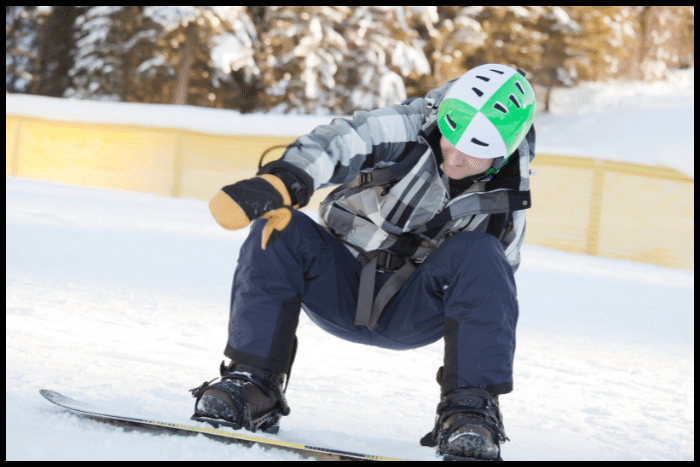
5b. Avoid Broken Wrists And Coccyx
Many beginner snowboarders wear wrist guards, as it is common to put your hands out to protect yourself during a fall. I used to wear them but weaned myself off them.
This is because the impacts become harder when you become a better rider, and wrist guards just divert the stress away from your wrists, up your arm. Still, they are great for beginner snowboarders.
Impact shorts absorb the shock from impacts when you land on your bum. This reduces the chance of injuring your coccyx (I can tell you from experience that this is extremely painful).
They also provide a bit of insulation for when you sit on the snow.
5c. Should You Wear Body Armor?
Most snowboarders don’t wear body armor, but it is available. This is usually a vest with protection for your upper body.
Although modern body armor is slim fitting, it can make you hot and sweaty while reducing your range of motion. Therefore, it’s not the best choice for beginner snowboarders.
However, wearing body armor is excellent if you have a pre-existing injury or condition. It will give you confidence and reduce the likelihood of exacerbating your issues.
6. Avoid Trial And Error By Taking Snowboard Lessons
If you want to manage your risk while learning to snowboard, receiving proper tuition is best.
Attempting to learn by yourself while renting a snowboard is dangerous, even if you have a friend who is willing to teach you.
This learning method can be painful, as you are just experimenting with different techniques to figure out how to snowboard.
However, an instructor can make the learning process much easier by teaching you the proper techniques and guiding you to the most suitable slopes for your skill level.
By learning how to snowboard correctly, you’ll progress faster and avoid developing bad habits that are challenging to break.
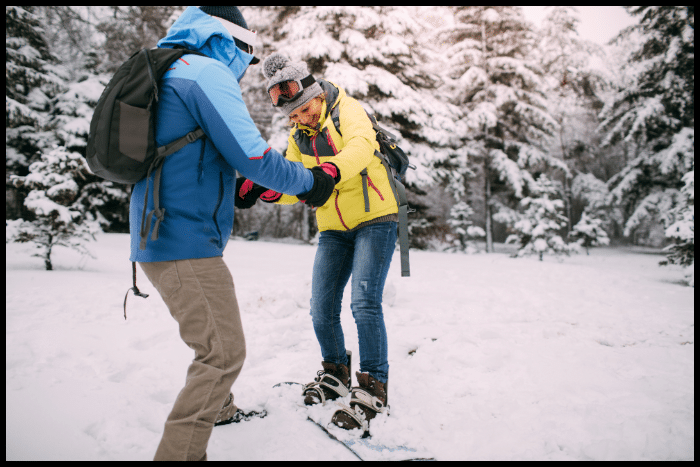
Final Thoughts
If you’ve got this far, you may think that snowboarding is too dangerous. If you’re concerned about the safety of snowboarding, it’s important to keep in mind that, like any sport, there are risks involved.
However, these risks are also what makes snowboarding enjoyable and fulfilling.
By using common sense, getting the proper education, and wearing appropriate protective gear, you can still have fun while minimizing potential dangers.
Remember, you can also adjust the level of safety to your personal preference. Some riders simply enjoy leisurely cruising around the resort and ending their day with a drink at the après bar.
